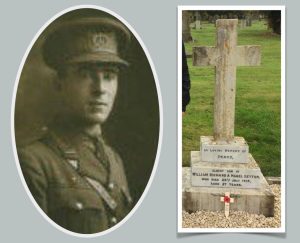Machine Gun Corps

Percy Geyton was born on 17 June 1892 at Lower Swell, near Stow-on-the-Wold, Gloucestershire.
He was the eldest of four boys born to William Richard Geyton and his wife Mabel Jane (née Gillett). William Gillett was the manager of the wine and spirit department of Cirencester Brewery in Cricklade Street.
Percy was educated at Cirencester Grammar School and after finishing his education, he joined the Capital and Counties Bank at Devizes and at the time of the 1911 census he was in lodgings in that town. He later served at the Stow-on-the-Wold Branch.
He enlisted for Army service on 10 December 1915 and initially served in the ranks (number B/23416) with the 11th (Service) Battalion, Royal Fusiliers (part of 54 Brigade, 18th (Eastern) Division). He was posted to France on 16 August 1916, almost certainly saw action during the autumn fighting of the Somme Offensive. The battalion was involved in the capture of the fortified village of Thiepval on 26 September 1916.
Anecdotally, he suffered from being gassed during this service on the Western Front and was also fortunate when either a bullet or a small piece of shrapnel struck a halfpenny coin held on his person, saving him from being severely wounded or killed.
For reasons unknown, he was invalided home either in late 1916 or early 1917 and commissioned into the 3rd (Reserve) Battalion of the Dorsetshire Regiment on 31 July 1917. This unit was UK based and thereafter he was seconded to the Machine Gun Corps at their base in Grantham, Lincolnshire.
He was discharged due to sickness on 23 January 1919 and returned to his career in banking, this time with Lloyds Bank Ltd (who had bought Capital & Counties Bank in 1918) at their Lombard Street headquarters in the City of London. His health deteriorated and in May 1919 he became ill and returned to Cirencester, where he died (reports conflict as to whether this was at home or in the Memorial Hospital) on 29 July 1919, age 27. The cause of death was valvular disease of the heart (hepatic), dropsy and syncope, all contributed to his war service.
He was buried in the Chesterton Cemetery at Cirencester on 2 August 1919, where a private stone cross marks his grave. He is also named on the memorial plaque outside the parish church as a casualty; however, he is not named on the Lloyds Bank war memorial.
Researched by Graham Adams 23 February 2019 with acknowledgements to Graham Sacker, Christopher Fear, National Archives File WO339/102653 and the Cheltenham Chronicle of 2 August 1919 for much of the above information.
